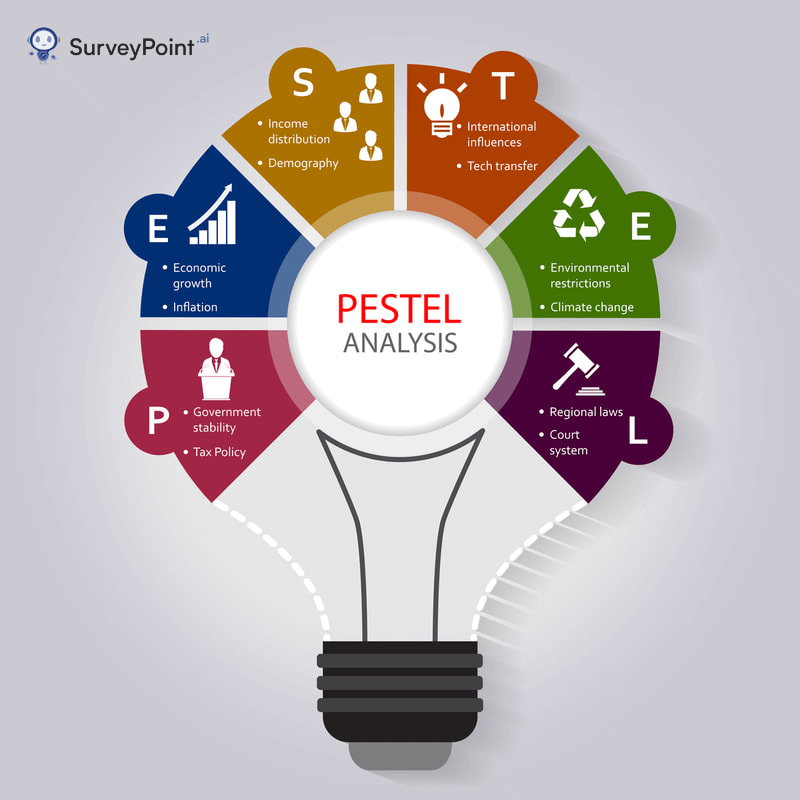
In today’s day and age, newer organizations are popping up by the second. The competition has gotten so heated that your decision can either make or break your business.
So, how do you sustain your business through the violent blows of market fluctuations?
How do you protect your business from seemingly random political, social, technological, developmental, and economic factors? Enter PESTLE analysis!
A PESTLE analysis is a tool that covers all your business’s political, economic, social, technological, legal, and environmental aspects.
To explore the topic in-depth, continue reading the article as I’ll explain what PESTLE analysis means, its elements, and a PESTLE analysis example that will help you clear your doubts.
PESTLE Analysis Definition

Analysis of these five factors—political, economic, social, technological, legal, and environmental—is known by its acronym, PESTLE.
This vital instrument, also known as PESTEL or PEST, determines the influence of external influences on an enterprise. In addition, it clarifies the impact these elements can have on the long-term viability of a project or enterprise.
Over the years, the PESTLE framework has seen some changes as marketing gurus looked to perfect it. An additional E that stands for Ethics was thrown into the bunch to instill a demographical element while utilizing the framework for market research.
Each factor has its importance, which varies according to the type of industry. Hence, you must understand the depth of each factor of PESTLE.
Elements of PESTLE Analysis

A PESTLE or PESTEL analysis consists of six different factors that affect an organization uniquely. Here are the six factors:
Political factors
Factors relating to political interactions between governments, countries, and other political actors.
For example:
- Diplomatic relations between countries
- Political Continuity and Stability
- How governments function
- International/Foreign trade policies
- The possibility of political unrest
- The regularity of civil society
Economic factors
Factors that encompass the primary elements within the business environment that can impact your organization.
For example:
- Inflation
- Unemployment rates
- Exchange rates
- Interest rates
- Economic growth rates
- Corporate tax rates
Social factors
Factors that define mass consumer behavior and thinking. These can include quantitative factors, such as the average age, and qualitative factors, such as opinions.
For example:
- Education levels
- Demographics
- Social views
- Age distribution
- Disposable income
- Cultural stability
Technological factors
Factors such as technological developments, shifts, and patterns could directly or indirectly affect your business. Conditions on a global or regional scale can fall into this category.
For example:
- Internet connectivity
- Unambiguous technologies, like automation
- Growth in your industry
- Intellectual property
- The rate of technological change
- Research and development lifecycles
Legal factors
Factors such as current laws, regulations, and bills could affect the organization’s operations and current and future plans.
For example:
- Health and safety regulations
- Government policies
- Import/export laws
- Tax policies
- Anti-trust regulations
- Competitive regulations
Environmental factors
Factors that look at the impact of businesses on the environment and vice-versa.
For example:
- Natural disasters
- Climate change
- Weather patterns
- Resource availability
- Consumer health
PESTLE Analysis Example: Starbucks
Starbucks is an international coffee-chain brand known for its savory and overpriced drinks. With over 35,000 stores in over 80 countries, here’s what a PESTLE analysis example of the brand might look like:
Political
- Political activity and awareness in the countries
- Public and political sentiments regarding “Fair Trade” compliance and ethical sourcing practices
- The possibility of riots, wars, or conflicts in the locations that have a Starbucks shop
- Diplomatic ties and sanctions between the United States and the countries
Economic
- Economic booms or recessions in particular countries
- Exchange rate fluctuations impact supply chain processes
- The typical annual income of Starbucks customers
- Operating costs in various cities, states, and countries
Social
- Consumer Preferences and buying habits about Coffee
- How Consumer behavior changes in Response to economic conditions
- Age groups of customers who prefer Starbucks coffee
- Changing work patterns (remote vs location-based work mode)
- Uncertain preferences based on region, culture, and history
Technological
- The rise of usage of household coffee brewing machines
- Technological advancements in coffee farming and processing methods
- The rise of online marketing and interaction
- The rising use of international e-commerce
Legal
- Violation of the Starbucks logo, color design, and other intellectual property rights
- Varying tax obligations for various regions
- Tariffs, trade regulations, and customs
- Specific workplace legislation compliance
- Health and safety laws in factories, stores, and other facilities
Environmental
- Effects of farming and processing, including water usage and carbon footprint
- The environmental impact of single-use products such as straws, paper and plastic cups, and so on
- Natural catastrophes and extreme weather in regions where Starbucks coffee is cultivated
Conclusion
Because of its versatility, PESTLE analysis is often hailed as an excellent resource for enterprises. It alerts businesses to the possible impact of the six external factors on their organization.
This makes it easier for businesses to arm themselves against any problems arising from the PESTLE factors.
However, strategists need more than analytics and cognizance to bring about an effective approach. If your operations are disorganized, uncoordinated, and lingering in the planning phase, you can’t avail the full benefits of PESTEL analysis or any other strategy planning tool.
Not Sure Where To Begin?
Explore our solutions to discover what is most important to your customers,
clients, and prospects. And best of all – it doesn’t take any coding!
Free Trial • No Payment Details Required • Cancel Anytime




